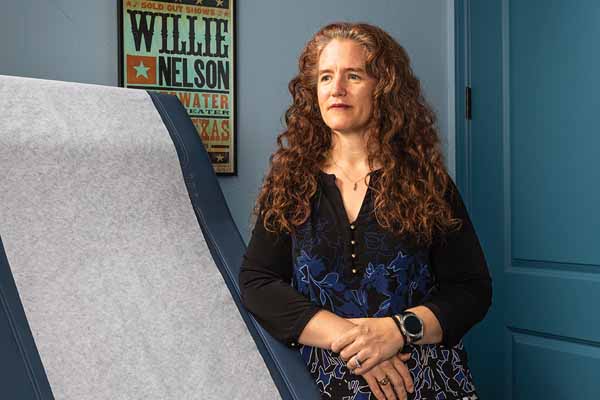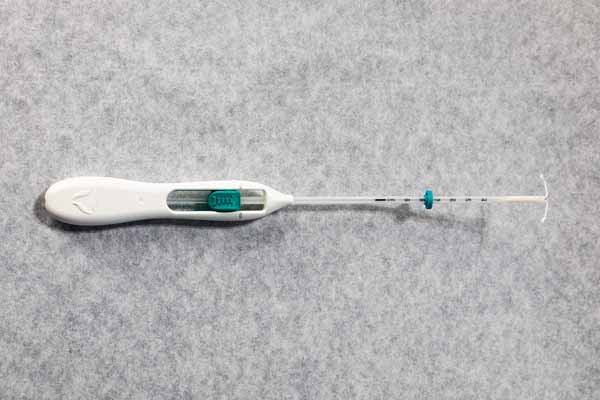
There are so many benefits of long-acting reversible contraceptives (LARCs) for women who need them it’s a shame many physicians have difficulty prescribing them, says New Braunfels family physician Emily Briggs, MD.
Women who use LARCs get the most reliable type of contraception possible – 99% effective – without having to worry about daily birth control pills, monthly shots, or other more cumbersome and less-effective birth control methods. And for some, access to contraception has a direct impact on their health, says Dr. Briggs, who chairs the Texas Medical Association’s Committee on Reproductive, Women’s, and Perinatal Health.
Unfortunately, Texas physicians can have a hard time getting LARCs to patients in a way that’s timely and affordable, Dr. Brigg says. That’s especially true for patients on Medicaid, which pays for 53% of Texas births, according to the Texas Health and Human Services Commission (HHSC).
The biggest barrier is price, Dr. Briggs says. LARCs, which consist of two types of intrauterine devices (IUDs) and the implant Nexplanon, can cost from $700 to more than $1,000. Meanwhile, rules for Medicaid and similar programs can discourage patients from getting LARCs or can actually cost physicians money to prescribe them.
“Which is why so many doctors don’t even mess with [LARCs],” Dr. Briggs said. “They say, ‘Go see the [federally qualified health center] or do the pill, do the shot, do something that I have in my office right now.’”
In November 2019, HHSC named boosting the use of LARCs as goal No. 1 for improving the health of women and children. The announcement came when HHSC released its first-ever annual business plan, “Blueprint for a Healthy Texas” (tma.tips/HHSCBlueprint2020). The LARC goal is one of 72 spread across 12 initiatives outlined in the plan.
The HHSC blueprint calls for increasing accessibility to LARCs “through outreach, enhanced partnerships, and reduced administrative burdens.” And it projects a 10% increase in LARC use for 2020 among patients in Medicaid, as well as Healthy Texas Women and the Family Planning Program, which offer women’s health and family planning services at no cost to low-income women. HHSC also plans to improve training for physicians and education among women about LARCs.
The HHSC plan came about in part because of efforts by individuals and organizations, including TMA, to reduce maternal morbidity and mortality with improved contraception and spacing between pregnancies, Dr. Briggs says.
“This focus [from HHSC] I think comes from literally years of the TMA and other interested people … really reiterating over and over again the importance of getting LARCs to be available to new patients,” she said. “We have such an excellent option here – an opportunity for patients to be able to self-direct their own contraception. And yet they can’t get it for one reason or another.”

Emptying the shelves
LARC use is widely seen as a best practice (www.texmed.org/LeveragingLARCs). The American College of Obstetricians and Gynecologists (ACOG) recommends LARC methods as the most effective and safe forms of reversible contraception. And TMA’s plan for reducing maternal mortality calls for legislation to make LARCs more easily accessible and for education to increase both patient and physician awareness of LARCs (www.texmed.org/8PointPlan).
However, Texas women find them difficult to get. A 2017 study by The University of Texas at Austin (tma.tips/UTLARCstudy) showed that although three-fourths of the 1,700 new mothers surveyed reported a preference for or interest in using a long-acting or permanent method of contraception, only half of those women actually used one of those methods six months after delivery. Most were insured at delivery through Medicaid or other public programs. “Provider and system-level barriers” were the main culprits for the difficulty in obtaining better contraception, the study concluded.
Patients who ask for a LARC should be able to get one right away, says Shanna Combs, MD, a Fort Worth obstetrician and gynecologist who is a consultant to TMA’s Committee on Reproductive, Women’s, and Perinatal Health.
“All the literature argues for same-day placement,” she said.
In part, that’s because women who wait for LARC insertion often fail to come back to get the procedure done, she says. Many women on Medicaid find it difficult to get off work or get transportation. In rural areas and inner cities, where physicians are scarce, getting back to the doctor’s office can be especially difficult.
Immediate insertion also prevents health problems for women who’ve just given birth by providing “pregnancy spacing” – at least 18 months between children – so they can recover physically and mentally, Dr. Briggs says.
However, the high cost of LARCs makes same-day insertion difficult for women on Medicaid and other publicly funded health programs, which pay for the devices in one of two ways: Physicians either can buy some ahead of time and dispense them as needed, or they can contract with a specialty pharmacy.
Buying ahead is out of the question for most physicians, Dr. Briggs says.
“Mine is a small practice and I’m not affiliated with a hospital, so I can’t afford to keep a bunch of IUDs sitting in my closet for a patient who might want one,” she said. “Instead, I do the contracting with specialty pharmacy.”
Another problem with buying ahead: Medicaid pays the physician for the LARC, but it typically pays at least $100 under the actual cost. That means the physician has to make up the difference, Dr. Briggs says.
To eliminate the cost barrier, HHSC allows physicians to order LARCs from a specialty pharmacy. But this system has its own problems, she says. Physicians must order a LARC for each individual patient, so the device won’t be available at the time of the appointment. Patients must then return to the practice for insertion – a hassle that often means women don’t bother.
And sometimes a woman changes her mind, Dr. Briggs says. For patients with private insurance, returning an IUD usually is not a problem. For Medicaid patients, physicians must keep the “abandoned device” for a minimum period of time depending on the instructions from the LARC manufacturer. And Texas State Board of Pharmacy rules prohibit physicians from reassigning an unopened device to another patient.
“The Medicaid system has barriers that make it so that my office has IUDs that just sit on the shelf until their sterility expires,” she said. “Once they’ve expired, I have to throw them in the trash.”
This is a common problem for OB-Gyns in Texas, says Tony Ogburn, MD, chair of the department of obstetrics and gynecology at The University of Texas Rio Grande Valley School of Medicine in Edinburg.
“I could give you many examples of providers who have 30 or 40 of them in their closet,” he said.
HHSC – following a directive from the Texas Legislature – says it will work with the Board of Pharmacy to study the feasibility of reassigning LARCs that have been rejected by the original patient. And since Medicaid payments for LARCs seldom keep up with the actual price of the devices, HHSC plans to review market rates for LARCs more frequently and adjust Medicaid payments accordingly, the agency says.
During the 2019 Texas Legislature, TMA advocated for HHSC to explore a new bulk purchasing process where physicians could order LARCs the way they order vaccines through the Vaccines for Children program run by the U.S. Centers for Disease Control and Prevention. Physicians could order the amount needed directly from the state on a quarterly basis at no charge, allowing them to have LARCs on hand, according to Helen Kent Davis, TMA director of governmental affairs. Lawmakers directed HHSC to evaluate the option.
 Less paperwork, more education
Less paperwork, more education
HHSC also plans to look at easing the LARC-related administrative burdens on physicians and hospitals.
For instance, some hospital systems are better than others at processing inpatient LARCs and then getting payments from payers, says Evelyn Delgado, president of Healthy Futures of Texas, a coalition of 87 organizations – including TMA – that works to reduce unplanned and teen pregnancies. Identifying and adopting more efficient administrative systems can guarantee that women who give birth at hospitals and want a LARC inserted immediately after delivery can get one, Ms. Delgado says.
A 2017 study published in Maternal and Child Health Journal found that of the roughly 238 birthing hospitals in Texas, eight had immediate postpartum LARC programs (tma.tips/LARCHospitalStudy).
Physicians also need help reducing the bureaucracy with specialty pharmacies, Dr. Briggs says.
“It’s the same problem you see around prior authorizations,” she said. “If I’m a good physician and a good steward of my resources, and through value-based payments I have proven I’m a [National Committee for Quality Assurance]-certified practice … maybe I don’t have to fill out all those prior authorization forms.”
HHSC has begun ranking the state’s regions by their LARC use. Mobile medical programs will soon help bring LARCs to women in areas where use is lowest, says an agency spokesperson.
The UTRGV School of Medicine has used this approach to help improve awareness, Dr. Ogburn says. The four counties that make up the Lower Rio Grande Valley – Cameron, Hidalgo, Starr, and Willacy – traditionally have had a low LARC use rate. Since 2018, the school has used a mobile clinic, Unimóvil, to visit isolated lower-income areas in the valley about once a month. Thanks to a grant, the school can provide LARCs to anyone who needs them.
The education efforts proposed by HHSC are needed because, while Healthy Texas Women and the Family Planning Program are helpful programs, the state does not do enough to advertise them to eligible women, Dr. Ogburn says. Also, many women who cannot afford a $1,000 LARC still make too much money to be eligible for those programs. Some who are eligible don’t apply out of fear that might hurt their immigration status (www.texmed.org/PublicCharge).
Physicians need education and training as well, Dr. Ogburn says. When he arrived in the Rio Grande Valley in 2015, he was the only physician in the four-county area certified to train other providers to insert the Nexplanon device. Since then, he and colleagues at UTRGV have trained more than 100 clinicians in the Rio Grande Valley. Similar gaps in physician training exist in other parts of the state, Ms. Delgado says.
HHSC says it will report back on its progress in its 2021 blueprint.
Tex Med. 2020;116(1):42-44
January 2020
Texas Medicine Contents Texas Medicine Main Page